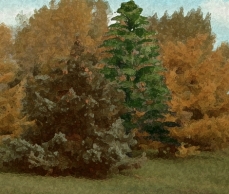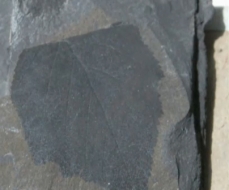Transcription of video clip The first trees
Since the beginning of time, a conquest of the skies

© Jardin botanique de Montréal
Archaeopteris
In this tree portrait, an intruder. Can you spot it?
It's Archaeopteris, one of the first modern trees on Earth.
This tree reproduced with spores, like modern-day ferns.
Thanks to the clues left in fossils, scientists can decode the history of tree plants that populated the Earth during different eras.
This fossil could be an ancestor of alders.

© Jardin botanique de Montréal
A fossilized tree leaf

© Jardin botanique de Montréal (Normand Cornellier)
This alder leaf looks like the fossil.
This one resembles the leaf of a hornbeam, a member of the birch family (Betulaceae).
The marks on the fossil are reminiscent of conifer needles.
This leaf, fan-shaped, is characteristic of plants that appeared during the Mesozoic, the era of the dinosaurs.
A single species has survived to this day. It is the Ginkgo biloba.
Ginkgos do not produce seed like conifers and hardwoods.
Their "fruits" are actually naked ovules.
On this fossil, it is difficult to imagine a tree. It is obviously a fern frond ...
We usually think of ferns as understory plants that are used to watch trees, these giants, from down under.
For example, on this picture in a greenhouse of the Botanical Garden, you've surely noticed ferns on the ground.
But these are also ferns. They are arborescent.
In the Carboniferous, 300 million years ago, tree ferns were the norm rather than the exception.
The Carboniferous was also populated by arboreal Lycophytes, a very old division of plants.
The ancient Lycophytes forests are the source of the coal deposits used during the industrial revolution.
Today, you will find their descendants looking down rather than looking at the sky.
Here are two representations of these now extinct arborescent Lycophytes.
Lepidodendron could have looked like this reproduction.
As for Sigillaria, it had two branches at most. A "Y"-shaped tree!
Note the diamonds on this fossil of a Lepidodendron trunk.
These are leaf scars: it bore leaves directly on its trunk.
During its growth, Lepidodendron had to reach a certain height before developing branches.
The leaves on its trunk allowed it to survive until then.
Can you imagine what these leafy pole-tree forests looked like?
In the Kew Botanical Gardens, in England, you can admire life-size replicas of these ancestors of trees.
Back to video clip




